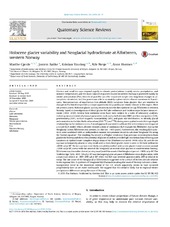Holocene glacier variability and Neoglacial hydroclimate at Ålfotbreen, western Norway
Peer reviewed, Journal article
Published version

View/
Date
2016-02Metadata
Show full item recordCollections
- Department of Earth Science [1034]
Original version
https://doi.org/10.1016/j.quascirev.2015.12.004Abstract
Glaciers and small ice caps respond rapidly to climate perturbations (mainly winter precipitation, and summer temperature), and the mass-balance of glaciers located in western Norway is governed mainly by winter precipitation (Pw). Records of past Pw can offer important insight into long-term changes in atmospheric circulation, but few proxies are able to accurately capture winter climate variations in Scandinavia. Reconstructions of equilibrium-line-altitude (ELA) variations from glaciers that are sensitive to changes in Pw therefore provide a unique opportunity to quantify past winter climate in this region. Here we present a new, Holocene glacier activity reconstruction for the maritime ice cap Ålfotbreen in western Norway, based on investigations of distal glacier-fed lake sediments and modern mass balance measurements (1963–2010). Several lake sediment cores have been subject to a suite of laboratory analyses, including measurements of physical parameters such as dry bulk density (DBD) and loss-on-ignition (LOI), geochemistry (XRF), surface magnetic susceptibility (MS), and grain size distribution, to identify glacial sedimentation in the lake. Both radiocarbon (AMS 14C) and 210Pb dating were applied to establish age-depth relationships in the sediment cores. A novel approach was used to calibrate the sedimentary record against a simple ELA model, which allowed reconstruction of continuous ELA changes for Ålfotbreen during the Neoglacial (when Ålfotbreen was present, i.e. the last ∼1400 years). Furthermore, the resulting ELA variations were combined with an independent summer temperature record to calculate Neoglacial Pw using the ‘Liestøl equation’. The resulting Pw record is of higher resolution than previous reconstructions from glaciers in Norway and shows the potential of glacier records to provide high-resolution data reflecting past variations in hydroclimate. Complete deglaciation of the Ålfotbreen occurred ∼9700 cal yr BP, and the ice cap was subsequently absent or very small until a short-lived glacier event is seen in the lake sediments ∼8200 cal yr BP. The ice cap was most likely completely melted until a new glacier event occurred around ∼5300 cal yr BP, coeval with the onset of the Neoglacial at several other glaciers in southwestern Norway. Ålfotbreen was thereafter absent (or very small) until the onset of the Neoglacial period ∼1400 cal yr BP. The ‘Little Ice Age’ (LIA) ∼650–50 cal yr BP was the largest glacier advance of Ålfotbreen since deglaciation, with a maximum extent at ∼400–200 cal yr BP, when the ELA was lowered approximately 200 m relative to today. The late onset of the Neoglacial at Ålfotbreen is suggested to be a result of its low altitude relative to the regional ELA. A synthesis of Neoglacial ELA fluctuations along the coast of Norway indicates a time-transgressive trend in the maximum extent of the LIA, which apparently seems to have occurred progressively later as we move northwards. We suggest that this trend is likely due to regional winter precipitation differences along the coast of Norway.
